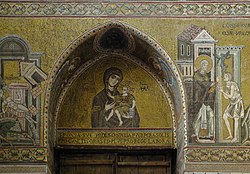Monreale Cathedral mosaics
[2] With the exception of a high dado, made of marble slabs with bands of mosaic between them, the whole interior surface of the walls, including soffits and jambs of all the arches, is covered with minute mosaic-pictures in bright colors on a gold ground.
The mosaics, which covering the upper sections of the sanctuary and nave walls, span approximately 6,500 square meters, as mentioned prior.
Byzantine art manifested in a variety of mediums, including painting, architecture, mosaics, metalwork, and ivory reliefs; however it is widely recognized for its use of opulent gold icons that continue to decorate many churches to this day.
[3] Byzantium constituted the eastern branch of the Roman Empire, which at one point, encompassed extensive territories across the Mediterranean, including present-day Turkey, Southern Spain, and Italy.
Justinian also then led the creation of the Hagia Sophia, while creating workshops dedicated to a plethora of art forms, including icon painting, ivory carving, etc.
[3] The Emperor pushed the dissemination of ideas and iconographic styles to Ravenna in Italy wherein the San Vitale church later came to epitomize the essence of the Byzantine era.
During the peak era of Byzantine style, it was also characterized by elongated figures, angular shapes and faces, defined edges, flattened hues, and is embellished with gold accents.
[3] This is evident in the Monreale Cathedral Mosiacs with the image of Christ the Pantokrater, where he has a sharp and more pointed face and the work is filled with gold accents and surrounding background.
There are also depictions of stories from the Bible represented within the many mosaic decorations of the Monreale Cathedral, including the journey of Noah's Ark along with the labour of Adam and Eve.
The subjects in the nave begin with scenes from the Book of Genesis, illustrating the Old Testament types of Christ and His scheme of redemption, with figures of those who prophesied and prepared for His coming.
Due to this lapse in knowledge and available information, an archaeometric investigation was executed, which worked to examine the materials that were used for the mosaic decoration of the South aisle wall of the Monreale Cathedral.













































